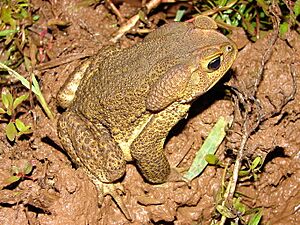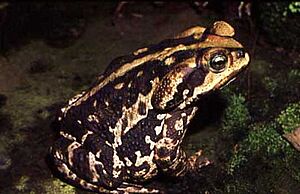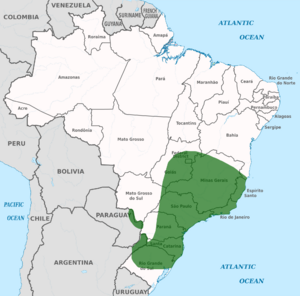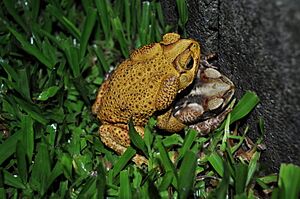Rhinella icterica facts for kids
Quick facts for kids Rhinella icterica |
|
|---|---|
 |
|
| Adult male R. icterica | |
 |
|
| Adult female R. icterica | |
| Conservation status | |
| Scientific classification | |
 |
|
| Range in green | |
| Synonyms | |
|
The Rhinella icterica is a type of toad often called the yellow cururu toad. It lives in parts of Argentina, Brazil, and Paraguay. The name "cururu" comes from a local language and describes the male toad's special singing sound, which is a gentle, trembling call. Sometimes, other toads that are similar are also called "cururu toads."
Contents
About the Yellow Cururu Toad
Yellow cururu toads are quite large and have strong bodies. Male toads can be about 10 to 16.6 centimeters (4 to 6.5 inches) long. Females are even bigger, growing up to 13.5 to 19 centimeters (5.3 to 7.5 inches) long.
These toads have special bumps behind their eyes called parotoid glands. They also have bony ridges on their heads. Female and young toads are usually yellowish with a light stripe down their back and black spots. Males are often a bright greenish-yellow with fewer black spots. Their bellies are white with brown patterns. Their skin has small, bumpy warts, especially on the males.
Amazing Defense Mechanism
The yellow cururu toad has a cool way to protect itself from danger. Like many amphibians, it has special glands in its skin. Some of these glands make mucus, and others make poison. The poison glands, called granular glands, are found all over its body. There are two large ones behind its eyes, one on each side. These are called parotoid macroglands.
When a toad feels threatened, it can puff itself up with air. It then points one of these large glands towards the attacker. If the gland is squeezed, it quickly releases poison. If a predator tries to bite the toad, the poison can shoot into the predator's mouth, making it sick.
What They Eat
Rhinella icterica is a common toad in southeastern Brazil. It likes to eat yellow scorpions (Tityus serrulatus). What's amazing is that these toads can eat scorpions without getting hurt by their venom! Scientists think this is because the toad's own toxic skin secretion helps protect it.
Habitat and Life Cycle
You can find the yellow cururu toad in the Atlantic Forest region, which covers southeastern and southern Brazil, eastern Paraguay, and parts of Argentina. These toads live in many different places, from thick forests to open grassy areas like the Cerrado savanna. They can even live in places where humans have changed the land.
Reproduction
When it's time to have babies, usually from August to January, these toads gather in large groups. They meet near permanent or temporary ponds and streams. They lay their eggs in the water, often around plants that are floating or underwater.
Conservation Status
The yellow cururu toad is an adaptable species, meaning it can live in many different environments. It is found in many protected areas, and for a long time, its population was not considered to be in danger.
However, recently, there have been some challenges. Because of more deforestation (cutting down forests) and new roads being built, it's becoming harder for these toads to reach the water they need for breeding. This has caused the number of yellow cururu toads to slowly decrease in some areas. When there are fewer toads, there can be more scorpions in those places, since the toads help control the scorpion population.



